
Can Crowdfunded Astronomy Work? (Op-Ed)

Mark Jackson is the founder of Fiat Physica. He contributed this article to Space.com's Expert Voices: Op-Ed & Insights.
The U.S. budget crises over the last decade have been particularly harsh to physics and astronomy. In 2004, the Hubble Space Telescope was nearly defunded until public outcry ensured its continuing operation. In 2011, the U.S. House Appropriations Committee tried to cancel NASA's James Webb Space Telescope, only for it to be saved by the U.S. Senate at the last moment.
That same year, the NASA Constellation Program was not so lucky. The five-year, $9 billion project was intended to succeed NASA's Space Shuttle Program and usher in a new era of human spaceflight. Many people anticipated that this project would lead to astronauts not only returning to the moon, but venturing as far into deep space as Mars. Deemed too expensive and behind schedule, it was removed in the 2011 federal budget.
In the face of a global economic downturn, one might ask why such astronomy funding should be a priority at all. My personal viewpoint — one that I believe is shared by many people — is that, if we do not try to understand our place in the universe, what point is there in doing anything else? But the public and Congress often need other, more tangible, reasons. For them, here's the best possible answer: Space research is an excellent technological and financial investment.
A vested interest in investment
In 1962, NASA established the Technology Utilization Plan, which makes NASA technologies available to the commercial marketplace. The research pioneered at NASA has led to nearly 1,800 spinoff technologies, including cellphone cameras, breast-cancer detection software, and airplane wing design so efficient it has saved more than 2 billion gallons of jet fuel.
For every dollar invested in NASA, spinoff technologies have boosted the economy by $7 to $14. If Americans want the next generation to continue to benefit from such technological developments, we need to invest in the space research of today.
Get the Space.com Newsletter
Breaking space news, the latest updates on rocket launches, skywatching events and more!
Just as crowdsourcing has emerged as a new way to solve immense scientific problems, crowdfunding is emerging as a way to address the immense scientific funding crisis. Crowdsourcing, in which many participants use the Internet to contribute bits of content toward a larger goal, has allowed problems of previously insurmountable scale to be efficiently analyzed and solved. Astronomy has been at the forefront of this "citizen science" approach.
For example, Galaxy Zoo invites the public to classify galaxies from the Sloan Digital Sky Survey, which then led to the Zooniverse, a collection of citizen-science projects in all areas of science (and even the humanities) that currently boasts more than 1 million members.
Crowdfunding physics and astronomy
Crowdfunding is simply crowdsourcing applied to fundraising. Rather than expecting a single patron to donate the full amount of a budgetary goal, many individuals make modest donations (beginning at just a few dollars). Such contributions are rewarded with "perks" ranging from high-resolution digital photographs to personal interaction with the research team and, at the highest levels, even co-authorship and endowments. Crowdfunding platforms have proven tremendously successful, but so far, none of these platforms has specialized in astronomy — and it's difficult to find such projects on the generic "anything goes" crowdfunding platforms. [Warp Drive and 'Star Trek': Physics of Future Space Travel (Op-Ed )]
To address this crisis, Fiat Physica is the first crowdfunding platform specifically for physics and astronomy. Our motto — Make Physics Happen — is what we do, connecting physics enthusiasts to research groups seeking support for projects that will shape the future of humankind. We already represent some of the world's leading research and educational institutions.

To provide a destination where enthusiasts can engage with space concepts in an accessible, relevant and enjoyable manner, we have a blog where we post articles that tie abstract concepts to concrete, everyday examples. We also sponsor monthly social gatherings in New York City to discuss astronomy in a relaxed environment. This is complemented by our interactive social media profiles for the space-enthusiast community to keep abreast of the latest developments in the field.
The academic community has been solidly behind this enterprise, with many colleagues offering their help to improve the funding situation. Some of them serve on our advisory board: Neil Turok, director of the Perimeter Institute for Theoretical Physics, who used his $100,000 TED prize to launch the Next Einstein Initiative; Sandya Narayanswami, formerly director of Foundation Relations at Caltech; and Edward "Rocky" Kolb, dean of physical sciences at the University of Chicago.
This is a tremendously exciting time in the astronomy community, one in which the public can now directly participate in the future of science. The future of physics can no longer be determined behind lab doors and at private galas.
Engage Fiat Physica on Twitter @fiatphysica. Follow all of the Expert Voices issues and debates — and become part of the discussion — on Facebook, Twitter and Google+. The views expressed are those of the author and do not necessarily reflect the views of the publisher. This version of the article was originally published on Space.com.
Join our Space Forums to keep talking space on the latest missions, night sky and more! And if you have a news tip, correction or comment, let us know at: community@space.com.










